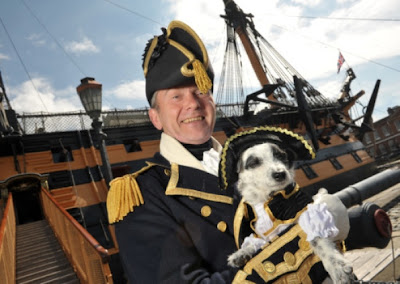Punitive Neckpiece
Helen Snell 2012
.jpg) |
Laser cut cardboard & spray paint, 98cm x 110cm
|
At first
glance, Punitive Neckpiece appears to
be decorative costume, reminiscent perhaps of Maori neckpieces with their
concentric circles of coloured beads. It can be exhibited as a stand alone
piece or as wearable sculpture.
The spurs
radiating from the centre suggest ivory tusks, serrated blades or dug out
canoes.
On closer
inspection the imagery reveals themes of, “massacre, burning, looting and persecution
of native peoples, with boats piled up with pots and stolen goods. Hands clutch
keys, grain and necklaces of trade beads that are in fact, human heads; cadavers
hang limply from the end of spurs”.
Punitive Neckpiece was
created as part of an on-going collaboration with the National Museum of the
Royal Navy, Portsmouth. After scouring the vast collection stores, a specific
object resonated with Helen – the Benin Tusk, which remains, to this day, shrouded
in controversy.
In 1897 the Royal Naval Brigade mounted an expedition to Benin
City, a strategic retaliation to avenge the killing of a British Officer who had
consciously violated their customs. As a result, Benin was sacked and purged of
its cultural identity. Highly prized ivory carvings, rich in spiritual
significance, were captured and hoarded by the British Naval Forces. Those that
weren’t destroyed were shipped to Britain in their thousands, to later be sold
by Queen Victoria's government - an event that marked the establishment of the
British colony, Nigeria.
Historic events like the Benin expedition rouse conflicting
opinions on an international scale. Therefore, notions of British Empire and colonisation,
particularly in a museum context, must receive ample attention. Punitive Neckpiece stages the meeting of
numerous perspectives. Helen comments on the irony in Victorian society seeing
itself as:
“…decent and philanthropic, as exemplified by their hero
David Livingston, yet the voracious empire builders greedily raced to carve up
Africa [in light of this] this neckpiece is also a yoke, a head restraint…”
The artwork is made of narrative snapshots where, “…the red at
the outer and inner extremities of the neck piece suggest areas of conflict,
flash points, disputed boundaries, blood loss and pain. The inner edge of the neck piece is serrated in sharp points, like a blast hole from a shell.”
Furthermore, Helen locks symbolism into the artwork through
a calculated colour scheme, “the red, white and blue can be seen as emblematic
of blood, sea, peace, the Royal Navy and a target area”. The artwork, with the vigorous rotations of its 19
laser-cut limbs, is charged with dense and frantic imagery.
When worn as a costume piece, Punitive Neckpiece bites the protruding head of its model. The spurs hang
precariously from a rigid brace; an artwork that responds to gravity.
In its original context the Benin tusk was the totemic
epitome of spirituality, revered as transcendental, it was the African’s mode
of cultural preservation; a window to their sacred past. These icons, with
their ceremonial images, linked the Oba (Emperor) to his ancestors and Benin to
its future. On seeing the photographs of the tusks in situ Helen said, “The
configuration is rather like an altar, very powerful and quite intimidating”. Now,
in British hands, in a museum context, this irreplaceable object is an “exotic” cultural trophy, set
to engage and intrigue visitors.


The seizure of Naval trophies such as the Benin tusk was not
uncommon. In fact, to this day, splinters of British colonisation fill museums
and galleries, leaving them inundated with similarly displaced cultural
remnants. The ethical grounding for possessing such objects faces endless scrutiny
and remains the source of extreme controversy in public and private collections.
In the same way that the tusk stood as an emblem in Benin, Punitive Neckpiece now stands as an emblem in itself, inviting
viewers to encounter, explore and lament the feats of British history.
Punitive Neckpiece
also acts a stark and timely reminder of the bleak consequences of territorial
ambitions; the same political motivations that shake the world today. Helen’s Punitive Neckpiece can promote new
perspectives on the art of collecting, whilst encouraging the re-evaluation our
Colonial past, finding new ways to make heritage relevant to visitors.









.jpg)






















